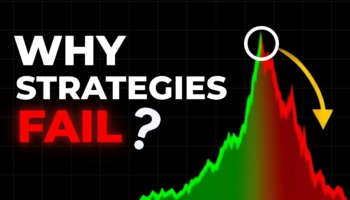
Why Your Backtests Lie – And How to Fix It
Have you ever built a strategy that looked amazing in backtests… only to lose money in live trading? The problem might not be your strategy at all.The real culprit? Your …
Přejít k obsahu | Přejít k hlavnímu menu | Přejít k vyhledávání
When developing algorithmic trading strategies, backtesting provides valuable insights into historical performance. However, a single backtest represents just one possible outcome based on the exact sequence of market events that occurred. In reality, markets are dynamic and unpredictable, with countless variables that could unfold differently. This is where Monte Carlo robustness testing becomes invaluable.
StrategyQuant offers several sophisticated Monte Carlo testing methods that help traders understand how their strategies might perform under different market scenarios. Each test addresses specific real-world trading challenges, from execution imperfections to changing market regimes. Let’s explore these five essential robustness tests that every serious algorithmic trader should understand.
What it tests: How robust your strategy is to changes in the sequence of market regimes.
The MACHR (Market Condition Historical Randomization) Block Randomization test addresses a fundamental question: “What if the same market conditions occurred, but in a different order?” This innovative testing methodology was developed by Marek Chrastina, multiple-times Top 3 finalist in the World Cup Trading Championship® (including 3rd place finishes in both 2020-2021 Global Cup Trading Championship and 2021 World Cup Championship of Futures Trading®).
Marek, who manages Quantum Global and focuses on algorithmic trading systems research and development, has been a long-time StrategyQuant user and contributor. His expertise in systematic trading and risk management has led to several valuable contributions to the StrategyQuant platform, including this sophisticated robustness testing approach. You can read more of his insights in his other StrategyQuant articles covering topics such as realistic performance expectations for algorithmic futures portfolios and basic approaches to futures portfolio diversification.
In real trading, market conditions don’t follow predictable sequences. Bull markets, bear markets, high-volatility periods, and consolidation phases can occur in vastly different orders. A strategy that performs well during one particular sequence might struggle if those same regimes appeared differently.
How it works:
For example, if your original backtest contained:
One simulation might generate: Block 2 → Block 1 → Block 2 → Block 4 (volatility-heavy scenario), while another might create: Block 3 → Block 3 → Block 1 → Block 4 (bear-market-heavy scenario).
By running 500+ simulations, you generate a distribution of performance outcomes reflecting how your strategy might perform across different possible “market histories.” A strategy showing consistent performance across all MACHR simulations demonstrates true regime robustness.
You can download this test here: Monte Carlo MACHR Block Randomization
What it tests: How resilient your strategy is to minor, unpredictable deviations from perfect backtest behavior.
In live trading, market conditions constantly evolve. Volatility shifts, liquidity fluctuates, and data feeds might have minute variations. Even well-optimized strategies might not perform exactly as predicted due to slight “jitter” in parameters or indicator calculations.
How it works:
The key insight is that these adjustments can be positive or negative, simulating minor variations in stop loss, profit target, or trailing stop execution points. This differs from fixed slippage because it introduces probabilistic disturbance directly related to the strategy’s potential internal parameter sensitivity.
One simulation might skip trades #3 and #25 while slightly improving trade #42, while another might skip only trade #15 but apply larger price adjustments to trades #8, #33, and #50.
You can download this test here: Monte Carlo Parameter Jitter
What it tests: How your strategy performs when facing execution imperfections like slippage and wider spreads.
Execution imperfections are common in live trading. Price slippage, temporarily wider spreads, and partial fills can cause actual closing prices to be less favorable than ideal backtest prices. This test models the impact of such random execution issues.
How it works:
Unlike fixed slippage applied to all trades, this test is probabilistic:
Each simulation represents a unique scenario. One might see trades #5, #23, and #58 degraded by small amounts, while another affects trades #12, #23, #45, and #70 with varying degradation levels. This helps assess strategy robustness against unpredictable execution variations.
You can download this test here: Monte Carlo Randomly Degrade Execution
What it tests: How sensitive your strategy is to variations in overnight funding costs at the individual trade level.
SWAP refers to the interest fee or credit applied when holding positions overnight in forex or CFD trading. It’s determined by interest rate differentials and can significantly impact strategy profitability, especially for longer-holding-period strategies.
How it works:
This test differs from the whole-backtest swap randomization by implementing unique swaps for each individual trade. One trade might have a positive long swap and negative short swap, while subsequent trades have entirely different swap combinations.
Running 500 simulations with randomized swaps for every trade provides a Monte Carlo perspective on how swap variations affect your strategy’s bottom line.
You can download this test here: Monte Carlo Randomize SWAP of Every Trade
What it tests: How your strategy performs under different but consistent swap rate environments.
While the previous test randomizes swaps for each individual trade, this test applies consistent swap rates across all trades within each simulation, better representing changing interest rate environments.
How it works:
This approach simulates different market interest rate environments rather than individual trade variations. For example, one simulation might represent a high-interest-rate environment with consistently higher swap costs, while another represents a low-rate environment with minimal swap impact.
You can download this test here: Monte Carlo Randomize SWAP of Whole Backtest
To maximize the value of these robustness tests:
For each test, run a minimum of 100 simulations, though 500+ simulations provide more reliable statistical insights. Pay attention to:
Monte Carlo robustness testing transforms strategy development from a single-outcome evaluation to a comprehensive risk assessment. These five StrategyQuant tests address the most critical real-world trading challenges: regime dependency, parameter sensitivity, execution quality, and funding costs.
A truly robust strategy should demonstrate consistent performance across all these tests. If your strategy shows high variance in any test, consider it a warning sign that requires further investigation and potential strategy refinement.
Remember: the goal isn’t perfect performance in every simulation, but rather consistent and predictable performance that you can confidently deploy in live markets. These tests help bridge the gap between backtest perfection and real-world trading reality.
For detailed instructions on importing these custom snippets to StrategyQuant, visit: Import/Export Custom Indicators and Snippets Guide

Have you ever built a strategy that looked amazing in backtests… only to lose money in live trading? The problem might not be your strategy at all.The real culprit? Your …

You spend hours generating strategies… find one that looks perfect… equity curve skyrockets, drawdown is tiny. 💰 But then—one week on demo, and it’s losing money. What went wrong? Chances …

Ever dreamed of a system that builds and tests trading strategies for you, even while you’re away from the screen? In our latest YouTube video, we show you how to …